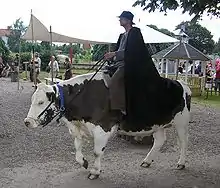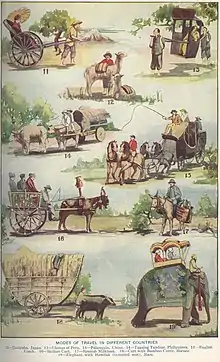Outline of animal-powered transport
The following outline is provided as an overview of and topical guide to animal-powered transport:

Animal-powered transport
Animal-powered transport – broad category of the human use of non-human working animals (also known as "beasts of burden") for the movement of people and goods. Humans may ride some of the larger of these animals directly on their backs, use them as pack animals for carrying goods, or harness them, singly or in teams, to pull (or haul) sleds or wheeled vehicles.
Animals domesticated for transport

_(14586963769).jpg.webp)
Terrestrial
Amphibious
- Turtle sea turtles were used for riding as a sport in early 20th Century Australia
Aereal
- Pigeon (for carrying messages)
Animal-powered vehicles
_-_Travellers_on_the_Way_-_WGA03568.jpg.webp)
Jan Brueghel (I) - Travellers on the Way, second half of 16th Century
- barge (sometimes pulled by humans)
- berlin (vehicle)
- Brougham (carriage)
- caravan
- carriage
- cart
- chaise
- charabanc
- chariot (ancient form sometimes used in combat, later a racing machine, later a name for something entirely different in carriages)
- coach
- Conestoga wagon
- curricle
- dogcart
- dray
- ferry
- float
- gig
- governess cart
- Hansom cab
- horsecar
- horse-drawn boat
- horse-powered boat
- Experiment (horse-powered boat)
- howdah
- litter (vehicle) (sometimes carried by humans, mainly used with equines, though occasionally camels)
- mail coach
- Michigan logging wheels
- omnibus
- bullock cart
- pantechnicon van
- Park drag
- phaeton (carriage)
- postchaise
- pulka
- railway
- rockaway (carriage)
- sled
- sledge
- sleigh
- stagecoach
- streetcar
- sulky
- tangah
- team boat
- telega
- towboat
- travois
- trolley
- van
- vardo
- Victoria (carriage)
- vis-a-vis (carriage)
- wagon
- wain
See also
References
| Wikimedia Commons has media related to Animal-powered transport. |
This article is issued from Wikipedia. The text is licensed under Creative Commons - Attribution - Sharealike. Additional terms may apply for the media files.